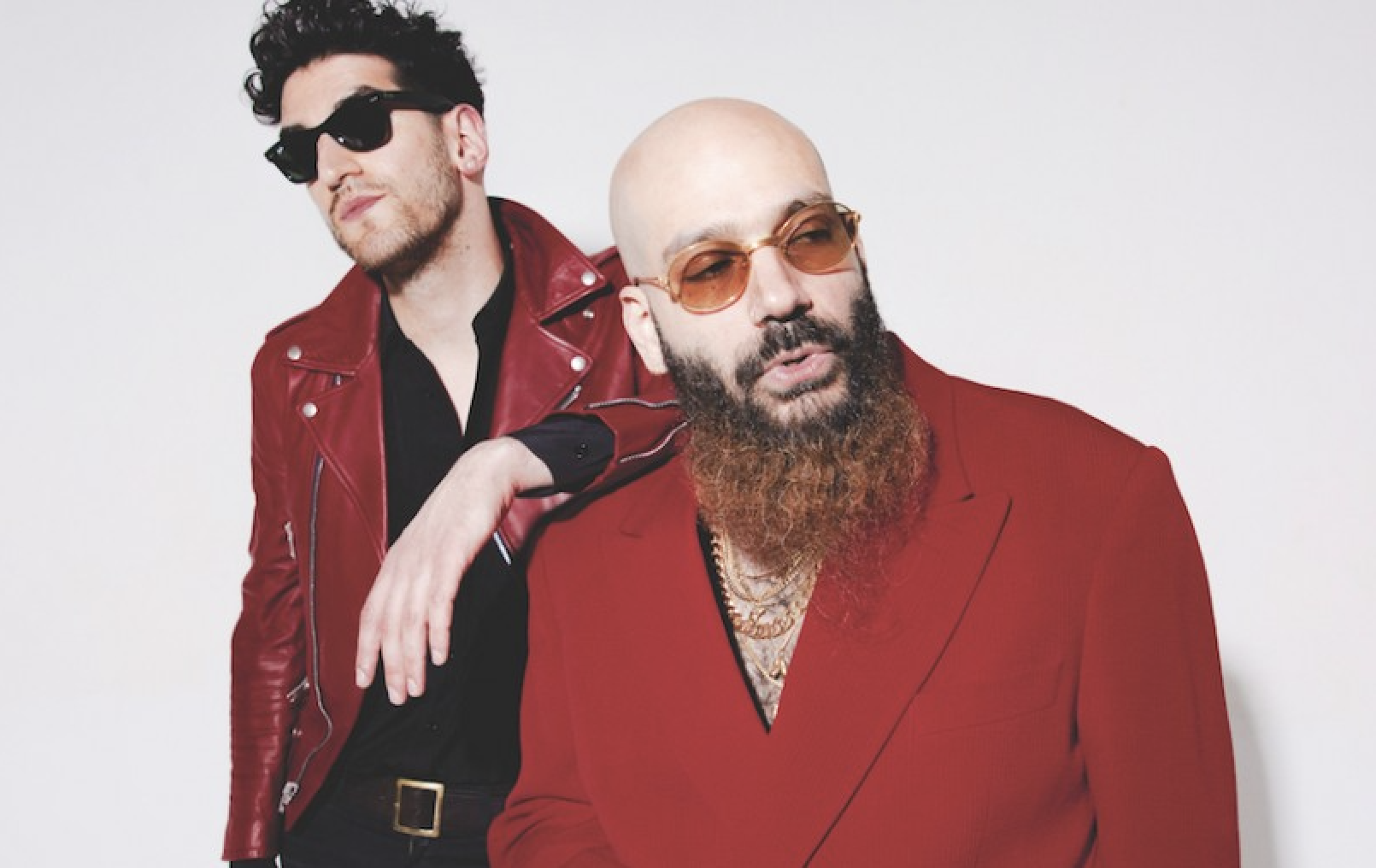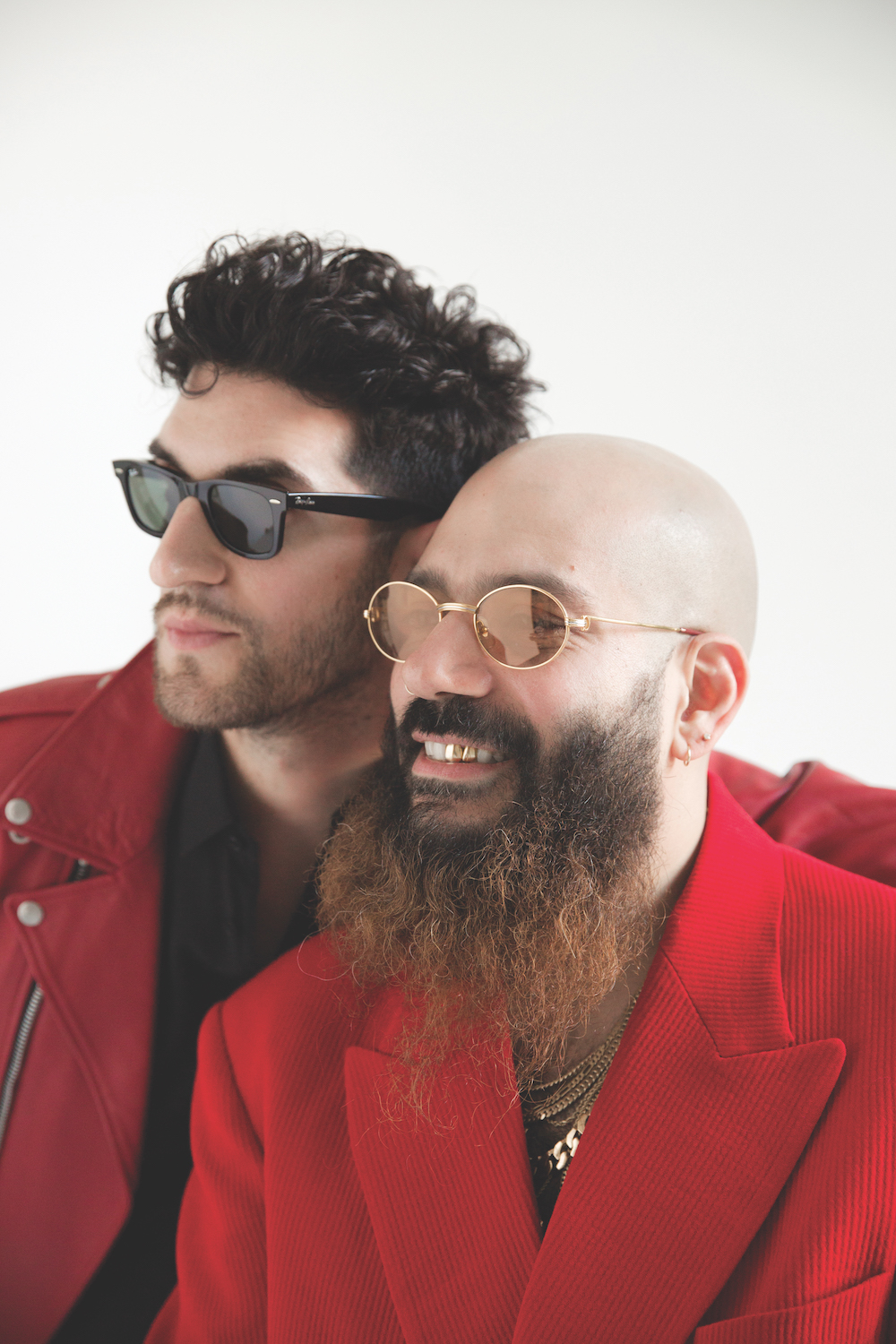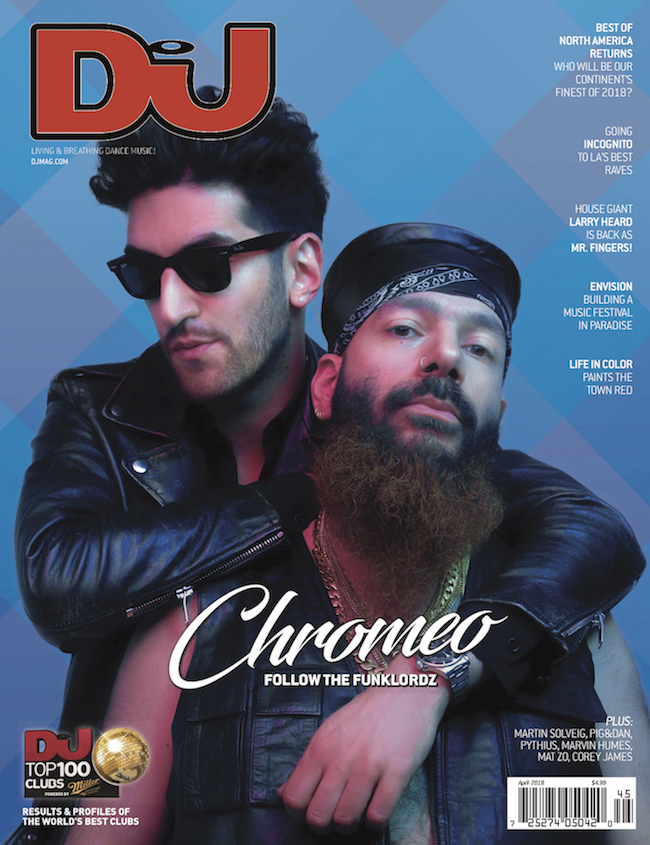Experiencing Chromeo is like taking a step back in time—but with all the luxuries and comforts of today. It’s in the duo’s music, which takes its cues from the funk and disco of the ‘70s, the R&B grooves and synth-pop of the ‘80s and the house and electro of the ‘90s. It’s in their live presentation which has the flair and showmanship of an era when entertaining through an exaggerated, audience participation performance was the norm. It’s in the visual aesthetic they present, reminiscent of Summer of Love concert posters, or disco 12”s, or glitter silkscreened t-shirts. It’s certainly in Chromeo’s studio, relocated to the city of Burbank in Los Angeles County, after many years of being housed in Brooklyn, New York, and originally set up in their hometown of Montreal, Quebec.
The Chromeo studio is a complex, the kind of place that usually houses a different music maker in each of its rooms. In this seven–room space, one room is occupied by Chromeo’s friends and DJ duo Oliver and one by Ryland Blackinton. The rest are used by Chromeo in some form or another: a live room, a rehearsal room, a production room, a tracking room and a synth room. Many of Chromeo’s rooms are like incredibly well-kept vintage synthesizer museums, except that here, you can touch everything. For Chromeo’s latest album, ‘Head Over Heels’, the finishing flourishes of which are still being administered, almost everything in sight has been involved.
This tangibility is one of the key elements that sets the duo – made up of Dave 1 and P-Thugg – apart from other artists that an algorithm might suggest when your browser’s cookies pick up that you’re checking out Chromeo. AllMusic spits out artists like Cut Copy, MGMT, LCD Soundsystem, and Justice, as related to Chromeo.

“We draw from the same references,” says Patrick Gemayel or “P-Thugg,” the bearded member of Chromeo, the one that is more often than not heard speaking through a talkbox, that is, when he’s heard talking at all. “It’s just a matter of how much.”
“They’re our peers, in a way,” David Macklovitch or “Dave 1,” the suit jacket-ed and booted, more vocal half of Chromeo says. “We came out at the same time. But the music is pretty different. We don’t mind because we like all those artists. But we listen to other stuff that an algorithm wouldn’t know. Jodeci and DJ Quik are huge influences on us growing up, but they’re not going to show up in algorithms, which are kind of evil. What’s scary about algorithms is that they may replace word of mouth.”
 |  |
|---|
At the time of Chromeo’s nascence, some 15 or so years ago, it was the golden age of music blogs, and of pirated music. This was a fortuitous point in musical time for the independent-minded music miner to discover a unique invention like Chromeo, one that wasn’t pop enough for the mainstream charts, not funk enough for the purists, and not electronic enough for the pre-EDM dancefloors and festival fields. This was particularly the case for the virtual crate digger looking for the rare remix or unreleased track and cultivating a stash, what now is called a curated playlist. These days, playlists are more commonly provided for the individual rather than created by the individual.
“There’s less incentive to do research,” Gemayel says. “But, on the other hand, someone who is working 45-50 hours a week doesn’t have time to search and be curious. They just want to be told what to listen to.”
Chromeo is happy to tell people what to listen to via Funklordz Radio, their playlist on Spotify that is like no other thematic playlist out there. “Our Spotify playlist is the anti-algorithm,” chuckles Gemayel. “We picked songs that had less than 500 plays. We are scratching the dark corners of Spotify.”
“The idea was to use it as a tool of discovery for our fanbase,” explains Macklovitch. “We’ve always said we wanted to be a connective tissue between the music we make and the context we’re in and what influences us. We love all music, from SoundCloud rap to weird electronic stuff, but we never want to hit people over the head. In terms of what comes into our music, our influences, it can be pretty esoteric funk and soul music. We started as record collectors in our teens and that’s still a part of us.”
It has been 25 years since the two met at school as teenagers and promptly started making music together. Over the course of five albums, the trajectory of Chromeo has not been a steady positive curve, but rather extreme giant leaps between releases. For ‘Head Over Heels’, Chromeo push further than ever before. A number of firsts are involved with this album, including bringing in legendary musicians, collaborating with songwriters, enlisting producers, and trying to recreate a Steely Dan fantasy for themselves. That is, “New York group moves to LA, gets all session players, even though they could play everything themselves,” according to Macklovitch.
“We can play every instrument, but we wanted other voices on this album, which is more funk and soul than our previous material,” he continues. “It’s grounded in electronic music and we work like electronic music producers, but jamming has never been our thing. We wanted that warmth of live instrumentation. We wanted to challenge ourselves to incorporate other feels, other touches, other sensibilities, other instincts to make Chromeo a more polyphonic thing. Whoever comes on a song, it ends up sounding like Chromeo anyway.”
‘Head Over Heels’ is the slickest Chromeo has ever sounded. The influences that were apparent in all their previous albums are brought to the forefront and put right in the listener’s face. This is experienced in the ‘80s R&B swinger ‘Juice’ and the aptly titled, smooth pantydropper ‘Bedroom Calling’ and the slapping, Prince-esque ‘Bad Decision’.
Part of this authenticity and warmth is attributed to the legendary musicians performing on ‘Head Over Heels’. Jesse Johnson, guitarist for The Time puts his inimitable stamp on the irresistible ‘Must’ve Been’, which also has DRAM’s honeyed vocals on it. Pino Palladino, bass player for The Who, shows up three different times on the album. Macklovitch and Gemayel went for it when finding musicians snatching up percussionist Lenny Castro, who has played with Toto and Mtume soul songstress Twatha Agee and living legend Raphael Saadiq. They didn’t just look to the past but also to the present with features from current talent such as The-Dream, French Montana and Ty Dolla $ign to keep ‘Head Over Heels’ fresh.
“Our music is not historically accurate,” says Macklovitch. “It’s from the mentality of an ADD kid from the ‘90s. We learned a lot of things through Beastie Boys and mixing up Lee ‘Scratch’ Perry with Run-DMC with Slayer. Our logo looks like ZZ Top and the music is funk in the broadest terms. From James Brown all the way to Calvin Harris featuring Frank Ocean and Migos, via Robert Palmer via Steely Dan via Bach.”
While all Chromeo’s material is rooted in funk, they make a concerted effort to have it intersect with as many subcultures as possible. But they are aware that they came from an electronic music background and have at least three remixes done for each song—and these are just the commissioned remixes. About 10 years ago they gave away the stems for their album, ‘Fancy Footwork’ and listened to reworks from anyone that tagged them on social media. They will be giving away the stems for ‘Head Over Heels’ as well, but if you’re itching to get your hands on the tracks in order to give your own take on them, the Chromeo guys will send them to you, you just have to ask.
Taking it a step further, what Macklovitch and Gemayel would ideally like to do is hold synth and production workshops while on the road for ‘Head Over Heels’. The idea is to partner up with a likeminded outboard or music software company and host small pop-up workshops for interested fans, who will be able to gain entry either by RSVP or contest winning. They are also hoping to reach out to their peers and have other electronic music producers and DJs who are in the region join in.

“It’s a little bit like our Spotify playlist idea,” says Macklovitch. “We’re at this point in our career where we want to share a lot of knowledge. We’re trying to promote a record, but it’s not just about us. It’s about all the things that come into our love of this music. We want to show kids what an analog synth is and how it works, how drum programming works and how to make danceable drum beats or funky basslines, the core elements of the music we make, give those tangible experiences to people.
He continues, “There are legions of kids that wear Supreme t-shirts and Thrasher t-shirts because of the appeal of the romance of skateboarding and the tangible experience of skateboarding. In the same way, manipulating vinyl or being in the studio filled with actual hardware or having live playing has a romance to it. We want to convey that on this record. I would have killed to be a fly on the wall when Raekwon and RZA and Ghostface Killah were making Raekwon’s ‘Only Built 4 Cuban Linx’ just to see what they were going for, what gear they were using, all the idiosyncrasies. Or when Daft Punk were making ‘Discovery’. There is a part of that we want to share. Some people might say, ‘Isn’t it better when it’s more mysterious?’ I don’t know about that. We want to be more open.”
“In the past, putting a demo of stuff out in the public would have been such a no-no,” says Gemayel. “Now we’re just busting clips of songs we’re working on and posting videos of us in the studio on all social media. People need visual information.”

The visual is something Chromeo has an inherent feel for, the airbrushed look for ‘Head Over Heels’ being no exception. There was a time, however, when their combination of sounds was not easily digested, and they relied on the visual to help their music go down easier. They take their cues from Alice Cooper, Iron Maiden, KISS, and Daft Punk, providing a show that works just as well at EDC as it does at Coachella, at their own Funk on the Rocks recurring event at Red Rocks Amphitheatre and at a private event for radio broadcast.
“We’re very much aware of the limits of what we do. We try to push ourselves with every album to convince more skeptics and also get more fans and also satisfy and challenge the fans we already have,” says Macklovitch. When they first emerged and were gigging with a lot of indie rock bands like The Rapture or Bloc Party or Scissor Sisters, in order to win the audience over, Chromeo provided, and continues to provide, an engaging live show that involves theatrics and high drama, extravagant moves and egging on of audience interaction, a fully committed, charismatic performance that the crowd thoroughly buys into. It all comes together in the end, and the fans can’t get enough of Chromeo, not by magic, but because when it comes down to it: “We are aware of the humor, at the same time the nerdiness, at the same time the paradoxes that are inherent in our music,” Macklovitch presses on then pauses before adding simply, the key ingredient to the otherwise complex Chromeo juice. “And we cultivate that.”
